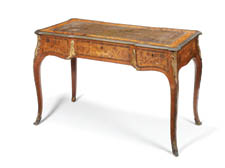| |

Lord Lucan’s ‘charming’ desk |
Sold, to the macabre gentleman
A DESK belonging to the late Lord Lucan is to be sold at auction.
Bonhams auction house has been instructed by Lady Lucan to sell the desk from their notorious former family home – 46 Lower Belgrave Street.
The aristocrat was found guilty of the murder of the family nanny Sandra Rivett shortly after disappearing in 1974.
He has never been seen since,
in what remains one of the greatest unsolved mysteries of the 20th century. He was declared legally dead in 1999.
The desk is a Louis XV style and is made of Victorian rosewood and tulipwood. It has a guide price of £5,000 – 7,000 and will be part of the Fine English Furniture and Works of Art auction on March 11.
Guy Savill, head of Bonhams fine furniture department said: “This charming 19th century desk is modestly priced, but because of its association with Lord Lucan and the mystery surrounding his disappearance, which continues to generate fascination decades later, the ale of the desk will doubtless arouse a great deal of interest.”
Kinetic energy
CARNIVOUROUS lampshades, pole dancing robots, man-animal-machine hybrids, mechanical writing machines, subliminal and sensitive installations, mesmerising light sculptures and cybernetics are some of the exhibits at a spectacular art fair dedicated to robots, dance and light in Marylebone.
The fair promises to be like “no other” and will be held at the P3 space beneath Westminster University in Marylebone Road.
The show runs from February 27-March 2. For more details see www.kinetica-artfair.com
Sometimes ‘impartiality’ can mean
the loss of truth
THIS is a horrific photograph that describes at a glance the carnage in Gaza – and one that could have appeared in any one of our national papers in recent weeks but didn’t.
Was it a matter of taste that held it back for publication? Possibly.
More likely it was decided that the photograph – taken by a photographer for the well known agency AP – would unfairly sway emotions where editors insisted on “impartiality”.
The photograph, in fact, appeared on the cover of a mainstream national glossy magazine I picked up in a hotel where I was staying in India during a recent trip.
It made me realise that sometimes the best way to judge the quality of our media is to compare its coverage of an event to that of another nation’s.
While the Israelis banned journalists from entering the Gaza war zone, our TV channels relied on Israeli supplied images. Occasionally, photographs by Arab journalists in Gaza were used but these were carefully chosen.
Anything too bloody or gruesome was obviously spiked.
Indian newspapers and magazines, however, were not afraid to show the suffering of the Palestinian civilians.
The caption below this shocking picture reads: “Israel savages Gaza in an attempt to eliminate Hamas, which runs a democratically elected government.”
How rarely, I thought – if at all – did our TV channels or newspapers refer to Hamas as having emerged the majority party in a fairly held election?
It is not as if Indian dailies I saw ran distorted reports on the conflict.
They were as objective as you could expect. It’s just that they were willing to show the effects of the war on the population far more honestly, I believe, than our media.
India is the largest democracy in the world. Its media is as free as ours.
It publishes well-produced dailies that can be compared in terms of quality to ours.
Am I alone in thinking that our reportage strained so hard to be “fair” that it sometimes obscured reality?
What links Queen Anne, the Freemasons and da Vinci?
WESTMINSTER Council doesn’t usually dabble in religious conspiracies. But they’ve made an exception this week in rubber-stamping plans to transform the street at the centre of the blockbuster novel the Da Vinci Code.
Great Queen Street, which links Drury Lane with Covent Garden, was once a secret pathway used by royalty as well as being close to the Freemasons’ Hall – headquarters of the Masons of England, which featured heavily in Dan Brown’s bestseller. Now it is being turned into a public square.
Those worried about negative portents can sleep easy though.
The Freemasons are supporting the plan to enhance the setting of their HQ.
The £640,000 improvement project aims to encourage greater pedestrian use of the area by creating an “oasis” beneath newly planted trees.
Great Queen Street was created in the 17th Century as a private lane for Queen Anne, King James I’s wife.
Councillor Danny Chalkley, cabinet member for environment and transport at Westminster City Council, said: “The West End has a rich history with unexpected sites around almost every corner.
“This is why it remains the best place in the country for shopping and entertainment.
“We’re advancing ambitious plans to renew the West End ahead of 2012 which will encourage even more visitors to venture off the beaten track and make walking around the centre of London easier and more enjoyable.” |
 |
|
 |
| |
| |








